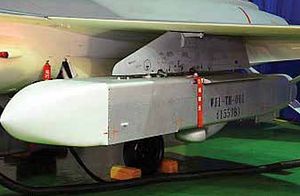Taiwan’s Wan Chien stand-off air-launched cruise missile has been declared fully operational, according to a report in the Taipei Times citing a Taiwanese defense official. Developed by the National Chung-Shan Institute of Science and Technology, the missile will given fighters in the Republic of China Air Force (ROCAF) an important new capability.
The Wan Chien cruise missile is estimated to have an effective range of more than 200 kilometers, allowing fighters bearing the missile to strike at targets across the Taiwan Strait without leaving Taiwanese airspace. The missiles can penetrate farther inland assuming they are released closer to the median line of the Taiwan Strait. The missile has been in development for years.
The ROCAF likely intends these missiles to serve Taiwan’s wartime anti-access/area denial objectives by striking key Chinese military logistics and staging bases on the mainland. The Wan Chien may also serve an anti-ship role. The missile is reported to be capable of delivering scores of secondary bomblets, making it ideal for area suppression attacks against military infrastructure targets on land. According to a source who spoke to the Taipei Times, the Wan Chien uses “GPS and inertial navigation system guidance.”
The missile underwent live-fire testing and evaluating recently, according to the Taipei Times. “One of the twin-seat fighter trainers fired one missile at surface targets in the seas to the southwest of Taiwan, while the other fighter and a Juiyuan drone monitored the exercise and transmitted real-time data to the institute’s Jioupeng Military Base (九鵬基地) in Pingtung County,” according to an official who spoke to the Taipei Times.
The missiles were designed with Taiwan’s F-CK-1 Ching-kuo multirole Indigenous Defense Fighter (IDF) in mind. These aircraft have been in service with the ROCAF since the mid-1990s. In 2017, the United States National Air and Space Intelligence Center, the U.S. Air Force’s intelligence unit that tracks ballistic and cruise missiles, among other air and space-based threats, published a photograph of the Wan Chien cruise missile mounted on the wing of a ROCAF IDF.
The Wan Chien, like all of Taiwan’s major indigenous cruise missile systems, was developed by the Taoyuan-based National Chung-Shan Institute of Science and Technology, the Taiwanese Ministry of National Defense Armaments Bureau’s primary research and development institution.
In addition to the Wan Chien, the NCSIST has developed Taiwan’s Hsiung Feng I, II, and III anti-ship cruise missiles, the Hsiung Feng IIE land-attack cruise missile, the Tien Chen air-to-air missile, and the Tien Kung air defense system. The institute additionally is involved in the development of unmanned aerial vehicles and rocket artillery systems.

































